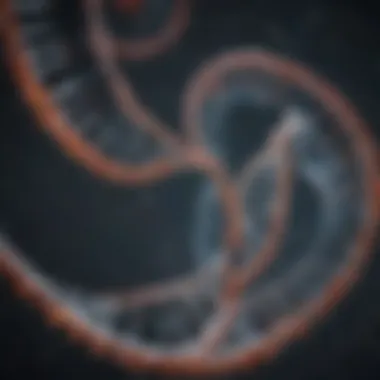Exploring the Intricate Machinery of Life


Intro
The complexity of life is a narrative painted by a myriad of interconnected processes and structures. From the microscopic dance happening within cells to the grand tapestry woven through evolutionary history, each element plays a critical role in sustaining existence. Life is not a monolith; it is a symphony of interactions that occur at various levels, each contributing to the whole.
Consider the cell, the fundamental unit of life. It operates with an inherent machinery, driven by biochemical reactions, signaling pathways, and genetic regulation. Each of these components doesn't just function in isolation; they communicate and cooperate, forming a cohesive unit that is necessary for survival. Metabolic pathways represent a particular aspect of this complex machinery, dictating how organisms harness energy from their environments and sustain their growth and reproduction.
As we delve deeper into this intricate structure, we will also consider issues of genetics—the blueprints that guide cellular functions and influence evolutionary outcomes. The connections do not stop at the cellular level; they extend into the ecosystems where these organisms thrive, highlighting their relationships with other life forms and the environment.
As this exploration unfolds, we will also touch upon how recent advances in scientific research are reshaping our understanding. Discoveries that once seemed distant are now at the forefront, providing new insights and possibilities.
Recent Advances
With the rapid pace of scientific discovery, we find ourselves in an era brimming with novel insights and technological strides that are rewiring our understanding of biological systems.
Intro to Life's Machinery
Understanding the complexities of life requires a look under the hood, so to speak. This section aims to illuminate the critical frameworks that underpin every living organism, from the tiniest bacteria to massive whales. Life isn't just a matter of survival; it's a dizzying interplay of mechanisms that sustain existence and promote growth. Knowing how these "machines" operate helps us appreciate the interconnectedness of life and the delicate balance of ecosystems.
When we talk about the "machinery of life," we’re really referring to the intricate systems and processes that govern how living organisms function. This encompasses everything from cellular structures to metabolic pathways. Think of it like the gears in a clock; each part plays its role and, if one piece falters, the whole mechanism can be thrown off balance.
In defining this machinery, we must also consider cellular components, such as organelles like mitochondria and ribosomes, which carry out specific tasks necessary for life. Understanding these elements is not just an academic exercise; it's essential for everything from medical research to biotechnology, highlighting just how intertwined life processes are with our daily existence.
Historical Perspectives on Biological Mechanisms
As the centuries rolled on, visionary minds like Antonie van Leeuwenhoek introduced microscopes. His discoveries of single-celled organisms shifted perspectives, opening doors to new realms of biological investigation. Later, the formulation of cell theory in the 19th century by scientists such as Schleiden and Schwann was crucial; they proposed that all living things are made of cells, laying the groundwork for understanding life's machinery on a cellular level.
Fast forward to the 20th century, with the discovery of DNA’s structure by Watson and Crick, fueling a revolution in molecular biology. This revelation fundamentally changed how scientists viewed heredity and genetic information transmission. Each of these milestones not only reflects individual brilliance but also demonstrates a cumulative building upon the knowledge of predecessors.
As research continues to advance, revolutionary technologies like CRISPR and artificial intelligence are now altering our approach to life's mechanisms, challenging ethical considerations and pushing the boundaries of what we thought possible.
Ultimately, reflecting on this history highlights not just the triumphs of science but also the continuity of inquiry that drives our understanding forward, reminding us of the intricate web connecting past discoveries to current knowledge.
Cellular Foundations
Understanding the cellular foundations of life is like peeling back the layers of an onion. Each layer reveals a complex yet orderly structure that underpins all biological processes. Cells are the fundamental building blocks of all living organisms, from the tiniest bacteria to towering trees. By examining these atomic units of life, we are not only exploring the smallest components but also gaining insight into how life functions on a grand scale. It’s in these cells that the magic happens—energy production, genetic information storage, and metabolic processes all unfold within their microscopic confines. This exploration sets the stage for a deeper comprehension of life’s machinery and its intricate interconnections.
The Role of Cells as Life's Units
Cells serve as the units that encapsulate life itself. Each type of cell has a specific role, much like actors in a play, where the performance of the ensemble hinges on each performer knowing their lines and cues. Prokaryotic and eukaryotic cells are the two primary classes that underscore the diversity of life. Prokaryotes, such as bacteria, are simpler and lack a nucleus, while eukaryotic cells, found in plants and animals, house their genetic material within a nucleus, allowing for more complex functions.
In the grand drama of life, the ability of cells to replicate, differentiate, and interact lays the foundation for diverse biological systems. This cellular organization is essential for growth, tissue repair, and the maintenance of homeostasis.
Cellular Organelles and Their Functions
Diving deeper into the cell, we encounter various organelles, each tailored to fulfill specific tasks that contribute to the cell's overall functionality. Organelles work in concert, much like well-oiled machinery, ensuring that cellular operations run smoothly.
Mitrochondria: Energy Production
Mitochondria are often dubbed the powerhouses of the cell, and rightly so. These organelles are pivotal in aerobic respiration, where they convert biochemical energy from nutrients into adenosine triphosphate (ATP), the cellular energy currency.
The hallmark of mitochondria is their double membrane structure, which creates compartments for differing biochemical processes. Their unique feature is the ability to adapt energy production based on the cell's current needs—if energy demand spikes, the mitochondria ramp up ATP production.
However, there's a flip side too. Mitochondrial dysfunction can lead to a myriad of diseases, demonstrating that while they are essential, they can also be a source of vulnerabilities within cellular life.
Ribosomes: Protein Synthesis


The standout characteristic of ribosomes is their ability to utilize various amino acids, linking them together to form polypeptide chains. This protein production is essential for cellular repair, growth, and function, making ribosomes a critical focus in studies of cellular metabolism and genetic translation.
Endoplasmic Reticulum: Metabolic Processes
The endoplasmic reticulum (ER) plays a dual role in a cell's metabolic processes. With two variations—the rough ER, clad in ribosomes, and the smooth ER, devoid of them—this organelle is like a workshop buzzing with activity. The rough ER is chiefly involved in protein synthesis and folding, while the smooth ER is linked to lipid production and detoxification processes.
A unique feature of the ER is its extensive network, resembling a highway system within the cell, transporting materials seamlessly across varied cellular locales. While the ER is essentials in maintaining cellular metabolism, issues can arise from its dysfunction, leading to protein misfolding and stress responses.
Cell Membrane Dynamics
The cell membrane, the gatekeeper of the cell, regulates what enters and exits, maintaining the delicate balance of homeostasis. It's not just a passive barrier; its fluid mosaic model emphasizes the dynamic nature, allowing for selective permeability, communication with other cells, and even nutrient absorption. This selectivity is vital for protecting the internal environment while allowing for interaction with the external world. In understanding membrane dynamics, one can grasp how cells adapt to their surroundings, respond to stimuli, and contribute to the overall machinery of life.
Genetic Information and Its Transmission
The intricate dance of life is rooted in the blueprints that every organism carries within its cells. This section explores the pivotal role of genetic information and its transmission in ensuring life sustains and evolves. Understanding these genetic underpinnings is crucial for comprehending the continuous cycles of heredity, adaptation, and innovation at play in nature. The elements we dive into—the structure of DNA, the nuances of gene expression, and the evolutionary currents shaping genetic systems—reveal how life not only survives but thrives in diverse environments.
DNA Structure and Function
DNA, or deoxyribonucleic acid, serves as the fundamental repository of genetic information. Structurally, it resembles a twisted ladder, commonly referred to as a double helix, with phosphate and sugar forming the sides and nucleotide bases—adenine, thymine, cytosine, and guanine—constituting the rungs.
- Key Features of DNA:
- Stability: The structure protects the genetic material from degradation.
- Replication: Each strand serves as a template for copying, ensuring fidelity in genetic transmission during cell division.
- Coding for Proteins: Genes within DNA sequences direct the synthesis of proteins, which carry out various functions crucial for life.
This dual role of DNA—providing a stable blueprint while ensuring adaptability through mutations—is central to life’s mechanics. The functional aspect of DNA extends beyond mere replication; it influences traits and characteristics observed in organisms. The depth of variation introduced through genetic recombination and mutations fosters resilience, allowing populations to adapt to changing environments.
Gene Expression and Regulation
Gene expression transforms the static information coded in DNA into dynamic biological activity. This process doesn’t happen all at once; it involves a detailed choreography of transcription and translation, each finely tuned by numerous regulatory mechanisms.
- Stages of Gene Expression:
- Transcription: DNA is transcribed into messenger RNA (mRNA).
- Translation: The mRNA serves as a template for assembling amino acids into proteins at the ribosome.
The regulation of gene expression is profound and multi-layered. Transcription factors and regulatory proteins can enhance or inhibit the transcription of specific genes, allowing an organism to respond to internal and external stimuli. For instance, in human cells, the expression of genes involved in insulin production can be modulated based on blood sugar levels. This regulation reflects not only cellular intelligence but also the marvellous adaptability of life as organisms respond to their surroundings.
Molecular Evolution of Genetic Systems
The ever-changing tapestry of life is woven through the lens of molecular evolution. This field studies how genetic systems have changed over time, leading to the vast biodiversity we observe today. Key concepts include how genetic mutations, natural selection, and genetic drift mingle to shape species.
- Major Factors in Molecular Evolution:
- Mutation: Random errors in DNA replication create new alleles, serving as raw material for evolution.
- Natural Selection: Environmental pressures favor certain traits, leading to adaptive changes in populations.
- Genetic Drift: Random changes in allele frequencies can have significant impacts, especially in small populations.
"Evolution is the process by which new organisms arise from pre-existing ones, using genetic change over generations."
This evolutionary framework elucidates how complex traits emerge, demonstrating that life is not a static existence but a dynamic journey. The molecular mechanisms that govern genetic information and its transmission provide the foundation for life, encapsulating an ongoing narrative of transformation, resilience, and interconnectedness.
Understanding these concepts in genetic information and its transmission enhances our appreciation of the symbiotic relationships inherent within biological systems. As we continue to unravel these mysteries, the potential applications, from agricultural advancements to medical breakthroughs, present exciting prospects for both research and practical implications.
Metabolism: The Energy Machinery
Metabolism serves as the engine room of life; it’s the collection of countless chemical reactions that occur within living organisms, enabling them to convert food into energy, grow, reproduce, and sustain their biological functions. Understanding metabolism is essential, as it underpins nearly every aspect of biology—from cellular activities to ecosystem dynamics. It reveals how organisms balance their energy needs with environmental constraints, thus maintaining life as we know it.
Catabolic and Anabolic Pathways


Catabolic pathways are often likened to breaking down a structure for parts. They involve the breakdown of complex molecules into simpler ones, releasing energy in the process. For instance, when glucose is oxidized, it's split into carbon dioxide and water, a process that releases ATP—adenosine triphosphate, the energy currency of cells.
In contrast, anabolic pathways are the construction phases. They require energy to synthesize complex molecules from simpler precursors. For example, during protein synthesis, amino acids are linked together to form proteins, which are vital for countless cellular functions, from catalyzing biochemical reactions to providing structural support.
This dynamic of catabolism and anabolism maintains a careful balance in metabolism, termed metabolic homeostasis. An imbalance can lead to disorders or diseases, underscoring the critical nature of these pathways in health.
Energy Transfer Within Cells
Organisms run on energy, and how it's transferred within cells is pivotal to their functionality. ATP production occurs mainly in mitochondria during the process of oxidative phosphorylation. This process can be viewed as a revolving door for energy; electrons travel through a series of proteins, leading to a proton gradient that drives ATP synthesis.
Once generated, ATP is used as a quick energy source. Whether it's muscle contraction, nerve impulse transmission, or nutrient transport across membranes, ATP acts like cash for cellular activities, enabling quick transactions of energy.
"Without efficient energy transfer, life would grind to a halt, as cells could not perform necessary functions."
In addition to ATP, other energy carriers, such as NADH and FADH₂, play crucial roles in metabolic processes, linking different pathways and ensuring continual flow of energy to fuel life.
Metabolic Regulation and Homeostasis
Metabolism does not function in a vacuum; it requires regulation to adapt to the body's needs. This regulation is maintained through various mechanisms, including hormonal control, feedback inhibition, and allosteric regulation. Hormones like insulin and glucagon subtly control nutrient availability, ensuring that metabolism adapts to feeding or fasting states. Feedback inhibition is a self-regulating mechanism whereby the end product of a pathway inhibits an earlier step, preventing wasted resources. This is crucial, as it saves energy and raw materials, and it keeps processes finely tuned.
Moreover, homeostasis refers to the bodily systems striving for equilibrium. If an organism absorbs too many nutrients, metabolic pathways are adjusted to avoid excess energy storage and potential obesity. In contrast, during scarcity, the body can initiate catabolic processes to release stored energy, showcasing an exquisite ability to adjust based on internal and external factors.
Understanding the machinery of metabolism extends beyond appreciating how organisms live; it also hints at evolutionary pressures and adaptations. Grasping metabolic pathways and their regulation is essential for developing interventions in diseases, enhancing agricultural productivity, and even addressing climate challenges linked to energy cycles.
Maintaining metabolic balance is a dance of reaction and response, of building and breaking down, a testament to life's intricate yet splendid machinery.
Interconnected Biological Systems
The concept of interconnected biological systems emphasizes how different components of the natural world are intertwined. Each organism does not exist in isolation; rather, it plays a vital role in a much larger web of life. These connections help maintain ecological balance, and understanding them sheds light on life’s machinery. Essentially, interconnected systems allow ecosystems to function properly, ensuring that energy transfer and material cycling occur efficiently.
Ecological Interactions Among Organisms
Ecological interactions are foundational to how ecosystems operate. They manifest in various forms, such as predation, competition, and mutualism. For example, consider a bee and a flowering plant. The bee relies on the plant for nectar while aiding in pollination essential for the plant's reproduction. Here, both parties benefit, showcasing a classic mutualistic relationship.
Below are some key interaction types:
- Predation: One species hunts another. For instance, lions preying on zebras.
- Competition: Different species often vie for similar resources, which can limit growth and survival chances.
- Symbiosis: Long-term interactions, which could be mutualistic, commensal, or parasitic.
The complexity of these interactions holds profound implications. An imbalance—like the drastic reduction of a predator—could spark a cascade, allowing prey populations to surge and disrupting local ecology.
Feedback Mechanisms in Biological Systems
Feedback mechanisms are crucial for regulating biological processes. Systems have ways to self-adjust, which is necessary for maintaining homeostasis. In simpler terms, they're responses that help keep everything in check. For instance, when blood sugar rises, insulin is released to lower it back to normal levels—this is a classic example of a negative feedback loop.
On the flip side, positive feedback amplifies responses. During childbirth, the release of oxytocin increases contractions, which in turn leads to more oxytocin being released until delivery.
Understanding these feedback mechanisms not only illuminates how biological systems maintain balance but can also reveal predispositions to diseases or disorders if these systems malfunction. This knowledge is significant for fields like medicine and environmental science.
Endosymbiosis and Cellular Evolution
Endosymbiosis is an integral concept that explores how symbiotic relationships can lead to significant evolutionary changes. This notion has its roots in the way certain organelles, like mitochondria and chloroplasts, are believed to have originated from free-living bacteria. According to the endosymbiotic theory, these bacteria entered primitive cells and formed mutually beneficial relationships, eventually becoming an essential part of the cell.
Key points about endosymbiosis include:
- Mitochondria and Chloroplasts: They contain their own DNA and replicate independently of the cell, an indicator of their past autonomy.
- Evolutionary Impact: This process highlights how cooperation can drive complexity in evolution, promoting the development of multicellular organisms.
- Modern Examples: Even today, some organisms have endosymbiotic relationships, such as coral reefs benefiting from photosynthetic algae.


Exploring endosymbiosis not only reveals insights into cellular complexity but also fosters a greater understanding of evolutionary biology, emphasizing the role of cooperation over mere competition in the survival landscape.
"Life is interconnected; understanding these interrelations is vital to grasp the essence of biological systems."
In summary, the study of interconnected biological systems allows researchers and scholars to explore the intricate dance of life. It sheds light on how organisms thrive together, how feedback loops can drive health or disease, and how evolutionary paths are shaped by alliances rather than only conflict.
Advancements in Understanding Life's Machinery
The rapid evolution of scientific techniques has shed light on the complex interplay of systems that sustain life. In recent years, advancements in our understanding of biological mechanisms have taken a leap forward, providing insights that were previously thought to be unattainable. Consider technologies like CRISPR and next-generation sequencing, which are revolutionizing how we comprehend genetics and cell biology. These innovations are not just theoretical — they enable us to manipulate life at the most fundamental level, allowing us to explore previously unexplored territories within biological systems.
Technological progress elevates our knowledge of the intricate workings of life. It offers solutions to pressing global issues such as disease control, food scarcity, and environmental degradation. As researchers leverage these breakthroughs, they uncover new pathways for research, bridging gaps between realms of science that once felt insurmountable.
"Innovation is the key that unlocks the door to understanding the fundamentals of life itself."
Cutting-Edge Technologies in Biological Research
Modern biological research has benefitted enormously from cutting-edge technologies. Techniques such as single-cell RNA sequencing allow scientists to observe gene expression at the individual cell level, revealing nuances that were previously hidden when looking at bulk samples. This level of detail provides a clearer picture of cellular dynamics and the diverse roles that different cell types play in living organisms.
Other noteworthy advancements include:
- CRISPR-Cas9: This gene-editing tool permits precise alterations to DNA, providing the capability to not only study genes but also to develop therapies for genetic disorders.
- High-Throughput Screening: Automating the testing of compounds against target biological processes accelerates the pace of drug discovery and development.
- Bioinformatics: Enhanced computational power allows researchers to manage and analyze vast datasets generated by modern experiments. This synergy between biology and informatics is critical for interpreting complex biological interactions.
The Role of Artificial Intelligence in Biology
Artificial intelligence is not just a buzzword; it has firmly established itself within the canvas of biological research. By utilizing machine learning algorithms, researchers can predict outcomes based on historical data sets, making strides in areas such as protein folding and disease modeling.
AI can synthesize large amounts of scientific literature and data, filtering through vast quantities of incoming information to surface critical insights. This capability is crucial in a world where information doubles every few years, making the ability to distill knowledge from chaos valuable. For instance, AI-assisted analyses in genomics can uncover rare genetic variations linked to diseases, facilitating tailored medical approaches.
Ethical Considerations in Genetic Manipulation
As we unravel the secrets of life, ethical considerations inevitably arise. The ability to edit genes and possibly alter the course of evolution brings forth profound questions about the moral implications of such capabilities. When discussing genetic manipulation, the delicate balance between innovation and ethicality cannot be overlooked.
Key ethical considerations include:
- Social Justice: Who has access to genetic technologies? Ensuring that advancements do not widen existing inequalities in health and medicine is critical.
- Biodiversity: Manipulating genes in organisms might have unforeseen consequences on ecosystems. The long-term impacts of releasing genetically modified organisms into the wild must be carefully evaluated.
- Informed Consent: As we venture into human genetic editing, the need for robust frameworks governing consent becomes paramount to respect individuals’ rights.
With advancements marching ahead, it’s crucial that society continually engages in discussions about the implications of our discoveries. Balancing potential benefits with responsible stewardship will determine how these remarkable tools are wielded for the greater good.
The exploration of life’s intricate machinery isn’t merely an academic exercise; it’s a profound inquiry into the essence of existence itself. In this article, we have journeyed through complex systems, from the cellular components that function as life’s fundamental units to the dynamic interplay of genes that govern biological behavior. Understanding these elements deepens our appreciation for the delicate balance and interconnectedness of all living organisms.
One of the pivotal insights uncovered is the complexity inherent in biological structures and processes. Life isn’t just about survival; it’s about intricate collaborations and sometimes chaotic interactions that bring about homeostasis. The feedback mechanisms woven throughout ecosystems highlight this interplay, suggesting that the loss or alteration of one small part can reverberate throughout the entire system. It leads to the thought-provoking consideration that every organism plays a role, no matter how minute.
Integral to life’s machinery is the role of technology in enhancing our understanding. Advances in research methodologies, particularly in the realms of genomics and artificial intelligence, provide new lenses through which to view biological interactions. These innovations enable us to dissect previously inscrutable processes, revealing hidden mechanisms that govern life, much like revealing the unseen gears within a clock.
The ethical discourse surrounding genetic manipulation weighs heavily on current discussions in the life sciences. Issues of consent, ecological balance, and long-term impacts provoke serious contemplation about our responsibility as stewards of this intricate machinery. Therefore, the article emphasizes not only the scientific advancements but also the moral and ethical considerations that come with them.
The Essence of Life's Complexity
Delving deeper, life’s complexity can be likened to a web; each strand represents a different biological interaction, contributing to an overall structure that is robust yet fragile. This complexity encompasses genetic, cellular, and environmental factors. It’s in the nuanced interactions where one can see the true beauty of life unfold.
For instance, think of the mitochondria, often referred to as the powerhouse of the cell. They don’t act alone; they rely on a host of cellular actions to function effectively. Similarly, ecosystems thrive on such connections. A break in any part threatens to disrupt the overall balance. The intricate dance of predator and prey or pollinator and plant showcases life’s delicate equilibrium.
Key points of consideration include:
- The interdependence of various biological processes.
- The unforeseen consequences of external changes on these processes.
- The continuous evolution of mechanisms within both the micro and macro biological scales.
Future Directions in Life Science Research
Looking ahead, myriad opportunities exist in life science research. As our tools and techniques evolve, so too does our understanding of critical biological processes. Researchers are increasingly exploring the frontiers of synthetic biology, a field that fuses engineering principles with biology to create new life forms or enhance existing ones.
In addition, the embrace of big data analytics and AI in biological research heralds a new era of discovery. Analysis of vast datasets can unveil trends and relationships previously hidden from view. This not only accelerates our understanding but also supports personalized medicine approaches, tailoring treatments to individual genetic makeups.
Of significance is addressing ethical implications as we advance. As science pushes boundaries, maintaining ethical oversight becomes paramount. Discussions surrounding gene editing, particularly CRISPR technology, need robust engagement to ensure that scientific advancements do not outpace moral considerations.















